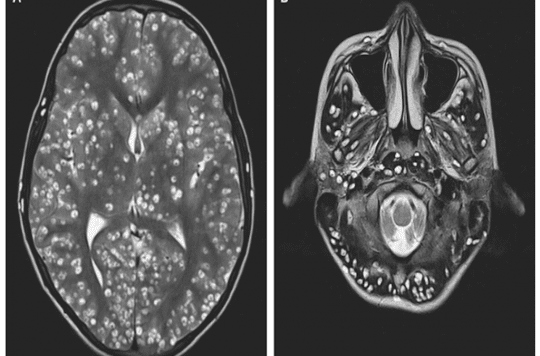Doctors have discovered dozens of larvae in the brain of an 18-year-old young man. Despite their efforts to save him, he succumbed to his neurocysticercosis two weeks later.

This is a particularly tragic ending. In India, an 18-year-old man died of neurocysticercosis, a parasitic infection of the central nervous system. Concretely, his brain was filled with encysted larvae, reports the review New England Journal of Medicine. If this affliction, a tropical disease most often affecting disadvantaged populations, had already been observed, this is a particularly extreme case.
Encysting larvae
The patient’s parents took him to Faridabab hospital. Because the young man suffers a lot on the right side of the groin and has regular epileptic seizures, they tell the doctors. The latter therefore made him pass an MRI and an ultrasound. They then discover that his cerebellum, his brainstem and his cerebral cortex are full of encysting larvae. The unfortunate is also affected in the right eye and the left testicle.
Diagnosis: The patient has neurocysticercosis, a parasitic infection of the central nervous system caused by a flatworm called the pork tapeworm (Taenia solium). If this disease has already been observed by doctors, here it is particularly advanced. The young man is so affected that the specialists cannot give him an antiparasitic for fear of aggravating his already very high intracranial pressure. Hoping to reduce the inflammation and control the seizures, they prescribed him a corticosteroid. In vain, the young man is already far too affected. He died two weeks after his visit to the hospital.
Tapeworm eggs
A few months ago, a similar case had already been reported in India, in Gurugram, where an eight-year-old girl had gone to the hospital victim of headaches and repeated epileptic attacks. Doctors then discovered cysts in her brain and prescribed a steroid drug to treat it.
Faced with the ineffectiveness of the treatment, they then gave him a scanner and detected a parasitic infection of tapeworm eggs in the form of a hundred white dots. The child, however, had been luckier than the young man whose case is reported above. After being treated with decongestants to reduce brain swelling and then treatment anthelmintic to destroy the parasitic worms and again steroids, she had been cured. She is now completely out of the woods.
An affliction that affects the most disadvantaged populations
Neurocysticercosis, commonly seen as an “underestimated tropical disease”, mainly affects poor populations living in unhygienic and rural environments. It is mainly present in Asia, Latin America and increasingly in Sub-Saharan Africa. However, due to increased traffic flows around the world, people living in developed countries sometimes fall ill. “In the United States, in recent decades, neurocysticercosis has become an important public health problem due to the increasing influx of emigrants, particularly from Mexico”, explains the René Labusquière Center, Institute of Tropical Medicine.
Typically, people become infected by consuming raw or undercooked meat or drinking water contaminated with T. solium eggs, explains World Health Organization (WHO) website. And because infected people most often live in extremely poor and remote areas, they may be sick for years without knowing it. However, without treatment, the condition becomes more and more serious as the larvae invade the tissues.
“The encystment of the larvae in the central nervous system, muscles, skin and eyes leads to neurocysticercosis the most serious form of the disease which is one of the frequent causes of epilepsy in the world”, explains the WHO. In addition to seizures, partial or generalized, the patient most often suffers from headaches, dementia, visual disturbances, dizziness, mental disorders, intracranial hypertension (nausea, vomiting, etc.) or even tremors.
.















